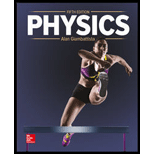
(a)
The number of moles of gas used in the engine.
(a)
Answer to Problem 100P
The number of moles of gas used in the engine is
Explanation of Solution
Find an expression for the number of moles.
Here,
Rewrite the equation (I) for
Conclusion:
Substitute
Thus, the number of moles of gas used in the engine is
(b)
The heat flow in the steps AB and CA.
(b)
Answer to Problem 100P
The heat flow in the step AB is
Explanation of Solution
Find an expression to find the heat flow in the step AB.
Here,
Substitute
Substitute
Here,
Find an expression to find the output work done.
Here,
Find an expression to find the heat flow in the step CA.
Here,
Conclusion:
Substitute
Substitute
Substitute
Substitute
Thus, the heat flow in the step AB is
(c)
The work done in each step.
(c)
Answer to Problem 100P
The work done in the step AB is
Explanation of Solution
Find an expression to find the net work done on the system.
Here,
Find an expression to find the work done in step BC.
Here,
Conclusion:
The work done in the step AB is zero as no work is done in a isochoric process.
The work done in the step CA is
Substitute
Substitute
Thus, the work done in the step AB is
Want to see more full solutions like this?
Chapter 15 Solutions
Physics
 College PhysicsPhysicsISBN:9781305952300Author:Raymond A. Serway, Chris VuillePublisher:Cengage Learning
College PhysicsPhysicsISBN:9781305952300Author:Raymond A. Serway, Chris VuillePublisher:Cengage Learning University Physics (14th Edition)PhysicsISBN:9780133969290Author:Hugh D. Young, Roger A. FreedmanPublisher:PEARSON
University Physics (14th Edition)PhysicsISBN:9780133969290Author:Hugh D. Young, Roger A. FreedmanPublisher:PEARSON Introduction To Quantum MechanicsPhysicsISBN:9781107189638Author:Griffiths, David J., Schroeter, Darrell F.Publisher:Cambridge University Press
Introduction To Quantum MechanicsPhysicsISBN:9781107189638Author:Griffiths, David J., Schroeter, Darrell F.Publisher:Cambridge University Press Physics for Scientists and EngineersPhysicsISBN:9781337553278Author:Raymond A. Serway, John W. JewettPublisher:Cengage Learning
Physics for Scientists and EngineersPhysicsISBN:9781337553278Author:Raymond A. Serway, John W. JewettPublisher:Cengage Learning Lecture- Tutorials for Introductory AstronomyPhysicsISBN:9780321820464Author:Edward E. Prather, Tim P. Slater, Jeff P. Adams, Gina BrissendenPublisher:Addison-Wesley
Lecture- Tutorials for Introductory AstronomyPhysicsISBN:9780321820464Author:Edward E. Prather, Tim P. Slater, Jeff P. Adams, Gina BrissendenPublisher:Addison-Wesley College Physics: A Strategic Approach (4th Editio...PhysicsISBN:9780134609034Author:Randall D. Knight (Professor Emeritus), Brian Jones, Stuart FieldPublisher:PEARSON
College Physics: A Strategic Approach (4th Editio...PhysicsISBN:9780134609034Author:Randall D. Knight (Professor Emeritus), Brian Jones, Stuart FieldPublisher:PEARSON





